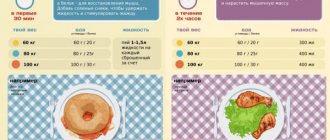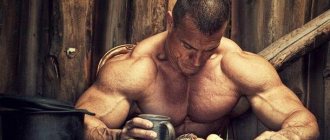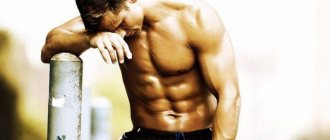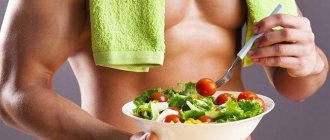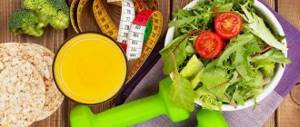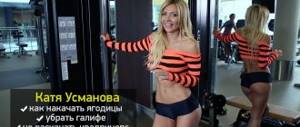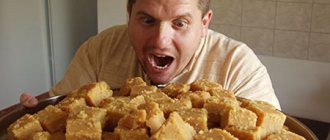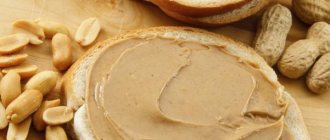In order to correctly answer the question of how long after a workout you can eat, you need information that allows you to understand what and when the body needs after the end of the workout in order to lose weight or, conversely, gain weight. Nutritional guidelines for losing weight or building muscle vary. This is facilitated by various biochemical processes in the body associated with training, sleep, and nutrition. Violation of one element from the list jeopardizes the entire training path and the desired sports result.
Is it possible to eat after an evening workout?
The answer to this question is obvious: eating after an evening workout is not only possible, but also necessary. Why? There are a number of objective reasons for this:
- Any physical activity, especially sports training, entails a large expenditure of energy. Energy reserves expended during exercise must be replenished, otherwise the body will regard this situation as starvation and will begin to actively store food, forming fat deposits.
- After intense evening workouts, the body needs not only to replenish expended energy, but also to restore muscles.
Both of these reasons are relevant both for those who want to gain weight and for those who want to lose weight.
Popular articles for weight loss and health
Intermittent fasting 16/8 for women menu
How long should a cardio workout last?
Recipes for dietary pancakes for Maslenitsa
PP pancakes with kefir recipe with photos for losing weight
When starting to exercise in the gym, it is important to understand: fasting will in no way contribute to weight loss, just as overeating will in no case provide you with an increase in muscle mass. Only a balanced diet and optimal balance of nutrients will help keep your body in great shape.
Anaerobic training and nutrition
Anaerobic means without oxygen, that is, when performing such types of exercise you spend less oxygen than during aerobic exercise. This can be explained using the example of two runners: a sprinter and a marathon runner. If you look at them, you will understand everything without me - one of them builds muscle and trains strength, and the other loses mass and trains endurance.
Now about the amount of oxygen. When running 100 meters in 10 seconds, the sprinter practically does not breathe, or his breathing is frequent and intermittent. The marathon runner is aimed at a different result - he must run as far as possible. If he holds his breath or breathes quickly, he will not run even 500 meters. He must adjust his breathing so that the supply of oxygen is constant and dosed. By oxidizing fatty acids with oxygen, a marathon runner provides himself with energy.
How does a weightlifter’s body work during training? The main source of energy during anaerobic exercise, that is, short-term exercise with heavy weight, is glycogen, that is, glucose. Yes, but glycogen is a substance found in muscle tissue, which means that during training we use our own muscles. To prevent this from happening, athletes who work to increase muscle mass need to receive additional carbohydrates and proteins in large quantities. Protein is the main building material for muscles. Without it, muscle growth is almost impossible. In general, anaerobic exercise burns fewer calories than aerobic exercise. However, the process of burning calories is delayed for another 48 hours after training - the body works to restore damaged muscle fibers.
The ratio of proteins/fat/carbohydrates in the diet of a weightlifter should be 30%/10%/50%.
What to eat to lose weight
If the goal of a woman’s training is to lose weight, then to make this procedure more effective, you need to pay attention to the foods that you need to eat before, as well as how long after training you can eat in order to lose weight. While the goal is to shed extra pounds, experts say intense workouts on an empty stomach are a bad idea.
Note! Sport involves additional expenditure of energy from the body. If it is not enough, then it is likely that you will not be able to train for a sufficient amount of time, because you will feel a strong feeling of hunger and the desire to lose weight will disappear.
Therefore, this situation is not ideal for achieving your weight loss goal. It can also wreak havoc on the muscles that use their glycogen stores to stay active. When choosing what to eat after a workout to lose weight, you need to consider what type of physical activity was used, the intensity, as well as your physical characteristics.
What to eat to lose weight with cardio
Nutrition during aerobic training to combat excess weight differs from the standard one. In this case, the diet is calculated in such a way that the menu does not cover 100% of the body’s energy needs, thus causing a kilocalorie deficit. At the same time, the person losing weight receives no less energy than is required for basal metabolism and SDD (that is, digestive processes). When combined with a moderate-calorie diet, cardio exercise is especially effective. From such nutrition a person receives a small amount of energy, and he takes the remaining forces that are necessary for muscle contraction and tissue repair after aerobic training from his own resources. Thus, diet and cardio exercises force the body to melt its own fats to maintain activity.
There are two experimental nutritional concepts for those who want to lose weight by dancing, tennis, swimming and other aerobic sports:
- The paleo diet (the brainchild of Walter Vogtlin) is a deliberately archaic nutritional system in which the basis of nutrition is red meat. Rejecting the achievements of agricultural evolution, scientists are advised to completely exclude cereals, dairy products and legumes from the diet. A significant drawback of the diet is that it can lead to vitamin deficiency, so you should not abuse it.
- The ketogenic diet (actively lobbied by researchers from Bettel University) is a nutritional system in which fats prevail over proteins and carbohydrate intake is minimized. Recently, the ketogenic diet began to be used as a sports nutrition system for high aerobic exercise. It is used by marathon runners and cycling participants - athletes who need large reserves of energy. The disadvantage of the concept is that the effect of fats on brain function has not yet been sufficiently studied.
A much safer option is to maintain a healthy proportion of BJU, gradually reducing your daily calorie intake. The norm for losing weight is considered to be a table in which protein foods make up 40-50%, fats – 20%, complex carbohydrates 30-35% and simple carbohydrates – up to 5%. In addition, clean water is useful for effective weight loss. By drinking 2.5 liters of this liquid per day, a person normalizes the water-salt balance, as a result, he sweats correctly during aerobic workouts and loses weight more easily.
List of allowed foods after training if you want to lose weight
What you need to eat after training to lose weight is indicated in the following table:
According to nutritionists, eggs are allowed for weight loss. You can boil them, prepare protein omelettes with vegetables. Among sweets, marshmallows, marmalade, and jam are allowed in small quantities.
Meat, fish and vegetables should be boiled or steamed rather than fried. It is recommended to season vegetable salads with olive oil.
What not to eat after training
To lose weight, you need to know what not to eat after training. To lose weight, you should avoid the list of products given in the following table after sports activities:
Caffeine is on the list of foods that are not recommended for girls to eat when losing weight after a workout, as it interferes with the proper absorption of protein. Fatty foods are also not what you can eat after a workout. Fats interfere not only with the absorption of proteins, but also carbohydrates.
How to gain weight
1. The foods in your diet should consist mainly of proteins and complex carbohydrates . Avoid sugary and fatty foods that will not benefit you.
2. Increase your caloric intake by 10% per week . To gain lean body mass, you need to train hard and also eat hard.
3. Use special nutritional supplements that will provide your body with the necessary elements. To gain muscle mass, an athlete needs to consume 2-3 grams. protein per 1 kg. weight per day. This is a large amount of protein and it will be very difficult to take it with food. Therefore, it is necessary to additionally take protein and other sports nutrition.
4. It is necessary to take a carbohydrate-protein mixture before and after training to provide the body with the necessary substances and preserve muscles.
5. Rest is very important for all athletes , and especially for those who are working to gain body weight. During sleep and rest, the body's most intense work on building muscle mass occurs. The main motto of all bodybuilders is “Eat a lot, train a lot, rest a lot.”
6. Eat often 6-7 times a day . It is necessary to receive energy constantly so that the body does not use muscle tissue for this.
7. Eat only wholesome, fresh foods. Eliminate all processed foods and canned goods. The food you take should be energy-rich. The basis of your diet should be foods with high nutritional value, mainly due to protein and complex carbohydrates. Foods such as fruits and vegetables should make up no more than 15% of your diet. They require too much energy to digest and have virtually no nutritional value.
Why eat after a late evening workout?
No matter what time of day the training takes place, morning or evening, you always need to eat after it. During exercise, the body spends 70% protein and 30% carbohydrates.
In order not to provoke the development of catabolic syndrome after training in the evening, the decomposition of the connective tissue of muscles, bones, blood vessels, the lack of protein and carbohydrates must be replenished: it is recommended to eat, even before bed, a little lean meat with vegetables.
Nutritionists do not recommend eating at night, but this does not affect active people who work out in the gym. They have a different diet. After a late dinner, it is advised to go to bed after half an hour.
The importance of proteins and carbohydrates in a late dinner
During active cardio and strength training, muscle connective tissue ruptures. The athlete receives microtraumas. After some time, the tissues are restored, increasing their volume. The body is transformed and becomes more prominent. Successful muscle regeneration requires protein and carbohydrates.
After training in the evening, a “carbohydrate window” appears, during which you need to eat or drink something containing protein: low-fat meals are preferable before bed. The “carbohydrate window” is a period lasting 2 hours.
All calories that enter the body with food will be spent on restoring expended resources. They do not contribute to an increase in fat deposits: a late dinner will not negatively affect your figure.
What to eat after a workout to lose weight
The breakdown of proteins leads to the formation of amino acids, which are used as building materials for muscle cells. Constant contraction of muscles during physical activity helps to get rid of excess fat and a person loses weight. Hence the conclusion: the more muscles we have, the easier and faster the body loses weight when we need it. In addition, muscles make the figure fit and attractive.
As a result of playing sports, muscle fibers wear out and lose their elasticity. The question immediately arises, what to eat after training to burn fat and maintain muscle? To restore muscle tissue, you need to consume enough protein.
Protein has both animal and plant origin. In this case, using animal protein rich in amino acids (especially those that are not produced by the body) will be the most optimal option.
Popular articles for weight loss and health
How Tatyana Ustinova lost weight: diet
Back exercises in the gym for men
Exercises for the pectoral muscles for women at home
How did Laysan Utyasheva lose weight?
To get rid of excess weight after training you need to consume:
meat (preferably veal); chicken or turkey (breast); boiled fish; cottage cheese (low fat).
It is optimal to add green vegetables and herbs to proteins. We recommend using natural fat burners.
At the same time, it is extremely important that the amount of food eaten is optimal, since overeating foods high in protein will lead to the fact that its excess simply will not be absorbed. This will cause complications in the functioning of the gastrointestinal tract and urinary system. Therefore, you should consume 30-40 grams of protein at a time. It would be preferable to eat fractional meals up to 5-6 times a day in small portions.
In addition, post-workout meals for weight loss for women should be enriched with carbohydrates. Carbohydrates accumulate in the liver and muscles. During physical activity, carbohydrates in the form of glycogen from the liver pass into the blood and are converted into glucose. From the blood, glucose is sent to various cells of the body, and its excess enters the muscles to normalize energy balance.
Experts say that after training you need to eat foods with a small content of glucose or fructose.
Don't forget that you need to eat in moderation and in a balanced manner after training to lose weight. Any protein-carbohydrate diet should be combined with vitamins and a complex of minerals.
As a result, we conclude that eating after exercise is not prohibited. The main thing is to choose foods for your diet that will help you quickly achieve your goal - to lose weight or gain weight.
Is it possible to eat after working out at the gym?
The list of necessary and permitted products depends on the type of exercise. Although each person is individual, the following options are suitable for everyone, you just need to increase or decrease the portion.
During the daytime
After strength training in the gym, you can eat:
Eating after a workout at the gym
- banana and milkshake;
- fish sandwich.
In addition, it is necessary to restore the water balance in the body, as it is lost during sweating.
Note! When exercising with a light load, it is enough to drink plain water, but if exercising with increased intensity, you will need to drink an isotonic drink to restore mineral salts in the body.
In the evening
After a moderate to high intensity workout, it is recommended to consume:
- yogurt or cottage cheese, fruit with honey.
- fruit salad and egg sandwich.
If the exercise is not too strenuous and you have 24 hours of recovery time, there is no need to follow a strict post-workout overnight meal routine. In this case, it will be enough to eat a small fruit and drink water to feel good in the morning.
After strength training
If a man's training is based on strength exercises to build muscle mass, it should be borne in mind that after this there is a decrease in the amount of glycogen in the liver, which is responsible for providing the main energy for this type of training. The amount of muscle protein also decreases.
Therefore, after such a workout, you need products that deliver carbohydrates to the body to restore the amount of lost glycogen and proteins to stop its destruction and allow the body to begin its restoration.
After a long workout
After a long workout
After a long time spent by the girl on a cycling machine, fats and glycogen were the main source of energy. After this type of exercise, their destruction may be less significant than after strength training, but it is still necessary to restore protein.
What to eat after training to lose weight? You can eat foods rich in carbohydrates: fruits, juices, cereals, bread, honey, jam, cocoa, and so on. Don't forget about protein-rich foods: dairy products (yogurt, cottage cheese, cheese), eggs and fish.
Note! These products can be consumed individually or in various combinations. After long workouts, you will have to eat more carbohydrates than after strength training.
Fats in the diet: should you give them up?
Lipid intake is an important point that must be observed during regular intense training. You shouldn’t give up on them, since fats are simply necessary for effective weight loss. They are part of a considerable number of hormones that promote the burning of fat deposits. In addition, fats included in the human diet make it possible to slow down the production of insulin. It is this component that converts glucose into subcutaneous fat deposits. If you eat foods rich in fat, the volume of your hips, waist or abdomen will gradually decrease.
The human body needs the right fats, which it does not produce. These are Omega-3 and Omega-6. Lean fish fillets, shrimp, mussels and squid are rich in similar components. Add such foods to your diet to ensure that physical activity brings the desired results. Fish can be baked, steamed or boiled.
But avoid fried foods, as they contain high levels of cholesterol. Animal fats are not as healthy, but they are necessary for the absorption of various vitamins. To replenish your supply of ingredients, eat a sandwich with butter in the morning.
The best time to train.
Aerobic training is almost any form of physical movement that involves you moving much faster than you would in normal life. This can be: easy, medium and fast running; cycling; swimming in different styles; boxing; work on the orbit track; walking for long distances [walk 5-10 km at a medium-fast pace]. Calculate the load in such a way that your health is not undermined in the end.
One time ago, an incident occurred with the famous athlete, video blogger and Russian Bodybuilding Champion Stanislav Lindover. Most bodybuilders only learned about him thanks to YouTube channels, in which he talks about nutrition, training, and at the same time shows how he lives, eats and trains himself. So, at one unfortunate moment, he released a video in which he honestly admitted that all his life he had been playing sports, lifting weights, drinking chemicals, and at the age of 50, doctors discovered that he had a heart defect. This is a problem in one of the heart valves, and sports are contraindicated. But he still trains, just moderately. So Stanislav said in the video that he alternated strength training with cardio. I thought they would strengthen the heart and develop the overall endurance of the body.
But that didn't save him. The heart suffered anyway, and my health eventually deteriorated.
So think about what you want and what you can do. If you are just starting to burn fat and have taken the right path, so to speak, start small. From walking. Monitor your breathing during physical activity. The work of the heart, lungs and the whole body as a whole.
Go home after work. Believe me, it's cool. Especially in spring or summer after work.
Distribute your training time according to your schedule. Don't listen to anyone who says the best workout is first thing in the morning on an empty stomach. Some people find it convenient to run in the morning, others in the evening. If you want to sleep soundly and feel like you are truly “waking up” in the evening, do aerobic exercise in the evenings.
When training to burn fat, try to avoid sports nutrition. The fact is that all the cocktails turn out sweet, and even though the manufacturer writes that there are high-quality sugar substitutes and zero carbohydrates per 100 grams of powder, in fact there are carbohydrates there. And they are harmful to us!!!
You can choose fat burners as assistants, or drink green tea or coffee before training. Most fat burners contain just these components.
Ratio of proteins, fats and carbohydrates (BJU)
After a workout, few people want to go to the stove, so the question of what you can eat after a workout in the evening without cooking remains relevant for many. But first you should figure out what substances you need to provide your body, as well as what ratio of proteins, fats and carbohydrates should be optimal in this meal. It is optimal to eat only healthy food after physical activity, and it is better to completely avoid all kinds of harmful “snacks”. Fast food, spicy, pickled, smoked, spicy, sweets and baked goods are completely prohibited at this hour. Pay attention to the two main components: proteins and carbohydrates.
The first substances are proteins; any athlete knows that our own muscles are made of them. They are responsible for properly organized metabolism in the body. In addition, they protect cells from potentially dangerous substances, supply them with the necessary oxygen and perform many other useful functions. Therefore, the basis of a late dinner after training is protein. This substance is found in abundance in lean meats, poultry, cottage cheese, Brussels sprouts, eggs and even buckwheat.
Diet plan for weight loss before and after workout
THE NUTRITION PLAN FOR WEIGHT LOSS DEPENDS ON THE TIME OF THE TRAINING.
Nutrition before training. Pre-workout meals include carbohydrates and proteins, but should exclude fats. Eating carbohydrates before exercise helps energize your brain and muscles. When performing exercises, such fuel will burn very quickly, and it must be glycogen, since fat cannot provide the required amount of energy due to oxygen deficiency. Proteins are not a source of energy, they act as building materials that help increase protein synthesis in muscles.
Fats should be eliminated before training as they slow down the speed of digestion and stomach function. Being in the stomach, fatty foods contribute to the appearance of belching, nausea and abdominal pain during exercise.
Before physical activity, it is best to consume the following foods:
- egg white omelet and oatmeal;
- chicken breast with buckwheat;
- poultry with rice or wholemeal bread.
Calorie intake on training days should be the same as on other days. Large portions of food, such as soup, leafy or vegetable salad, are best eaten a few hours before training, this time is enough for complete digestion and emptying of the stomach. Cottage cheese or porridge should be eaten half an hour before, but in small quantities. If the goal of exercise is to build muscle mass, then half an hour before exercise you should eat any fruit with a low glycemic value, a pear or an apple, which must be filled with a protein drink. Also, to mobilize fat from fat cells, you should drink strong tea or coffee 30 minutes before the start of exercise, which will allow you to use fat reserves as fuel, burning less glucose, amino acids and glycogen, but more fat. Following this rule will allow you to delay the onset of fatigue and carry out more intense exercise. The effect of caffeine lasts for two hours. It is worth noting that before the workout itself, you must refuse to eat so that physical activity does not interfere with digestion. If you feel very hungry, you can drink a protein shake.
Post-workout nutrition. The first meal after exercise should be no later than 20 minutes; if you refuse to eat for several hours, the effect of the workout will be zero, there will be a slight burning of fat, but there will be no acceleration of metabolism, no increase in muscle fiber density and strength. In the first 20 minutes after physical activity, an anabolic window is open for the intake of carbohydrates and proteins; fats should be excluded. All food consumed during this period will go towards muscle growth and restoration; fat deposition does not occur. To build muscle, you should consume carbohydrates in liquid form after a workout, such as sugar-free grape or cranberry juice. To calculate the amount of carbohydrates, you need to multiply the weight by 1 g. Products such as vegetables, rice, and buckwheat are also allowed.
IT IS VERY IMPORTANT TO LOAD WITH PROTEIN AFTER PHYSICAL ACTIVITY, BETTER IN THE FORM OF A PROTEIN COCKTAIL. IF IT IS NOT POSSIBLE TO CONSUME PROTEIN, YOU SHOULD EAT EGG WHITES.
In the first hour after class, you should eat any protein food, calculating your norm. The goal of post-workout nutrition is effective and rapid muscle growth and recovery; consuming fat helps slow down the intake of proteins and carbohydrates.
The protein should be low-fat; it is better to give preference to chicken fillet and egg white. Pork and beef should be avoided due to their high fat content; veal is the ideal choice. Also, cottage cheese and dairy products, yoghurts and cheese contain fat, so it is better to avoid them, with the exception of fatty fish, which contain healthy Omega 3 and 6.
For two hours after training, the diet should be free of foods containing caffeine: chocolate, cocoa, tea and coffee, since this substance prevents glycogen from being reloaded into the liver and muscles due to the introduction of insulin into the work. Therefore, if the workout takes place in the morning, strong coffee can be consumed only after a couple of hours; after drinking the drink before the workout, you will remain alert and energetic for a long time.
Training in the morning. Diet before and after training
If the workout takes place in the morning, then immediately after waking up you need to eat carbohydrates, such as an apple or banana, or porridge, after which you can start exercising in about an hour. If you don’t have the opportunity to have breakfast, you can drink juice without sugar 15 minutes before. After training, the body should receive low-fat proteins; to do this, just drink a protein drink or eat 150 g of chicken. This diet is suitable for strength training, but for cardio exercises, on the contrary, before training you need to create a glycogen deficit, this is the only way fat burning will occur. An hour before class, you should eat only protein foods, such as fish, chicken, low-fat cottage cheese or a protein shake.
Training in the evening. Diet before and after training
Not everyone has the opportunity to exercise in the morning, so the training takes place in the evening.
To lose weight and achieve results, you need to eat right before and after exercise. Nutrition before training. If the goal of exercise is weight loss, then a few hours before cardio exercise you need a carbohydrate meal, for example, vegetables, cereals, wholemeal products. These products include: omelette with vegetables, bran bread with pate, fruit with cottage cheese.
In order to lose weight, you need to create a calorie deficit, i.e. Energy expenditure should be greater than income, the amount of carbohydrates consumed should be up to 20 g, protein should be up to 15 g.
Before playing sports, you should drink a protein shake in the form of quickly digestible protein (about 20 g). During the day, nutrition should be complete, including three main meals, while fatty, fried, smoked and sweet foods should be completely excluded.
Post-workout nutrition. Nutrition after exercise in the evening is especially important. When performing a high-intensity fat-burning exercise, it is necessary to exclude any food intake. You should drink a protein shake in the first three minutes, which will close the carbohydrate-protein window, helping to restore and strengthen muscles.
When losing weight, you should eat small portions, at least five times a day, every 2.5 hours. Therefore, if before the workout the last meal was 2-2.5 hours and the same after, then during the break you should definitely have a snack with a protein drink.
Proteins, fats and carbohydrates: their role in an athlete’s nutrition
Any food product contains greater or lesser amounts of any of the three vital nutrients. These are proteins, fats and carbohydrates. Each of these components plays a specific role in the body:
After digestion, protein breaks down into amino acids. It is a building material for cells throughout the human body. Muscles, organ tissues, blood vessels - all this is built from amino acids. Proteins in the diet affect digestion, respiration, blood clotting. They are also responsible more than other nutrients for muscle contractions and nerve conduction. A deficiency of amino acids and protein leads to muscular dystrophy, weakness, low performance, and increased excitability. Eating after an evening workout requires the presence of protein - this is necessary in order to saturate the muscles with amino acids and prevent the process of catabolism (muscle breakdown) from starting at night.
Fats are a source of energy. With an excess of this nutrient, excess weight begins to accumulate. The layer of subcutaneous fat increases. As a result, the person is diagnosed with obesity. You cannot completely give up fats, but you should strictly regulate their amount in the diet. Foods containing fats are indispensable during heavy physical activity and in cold weather. The quality of the fat also matters. For example, unsaturated fatty acids are essential and enter our body only with food, mainly vegetable oils. You should opt for cold-pressed unrefined olive, flaxseed, sunflower, cottonseed, sesame oil.
Carbohydrates are the main element that supplies the human body with energy. Carbohydrates can be simple - glucose, fructose, galactose; as well as sucrose and lactose. They are absorbed instantly, contribute to a jump in insulin, which is why a person begins to feel hungry and eats more than necessary. As a result, the layer of subcutaneous fat increases and excess weight accumulates. Complex carbohydrates are not so dangerous in terms of obesity - they are starch, fiber, glycogen. Carbohydrates must be present in moderate amounts in an athlete’s diet for normal muscle growth. Complex carbohydrates are also an excellent source of energy. With their deficiency, a person becomes lethargic, incapacitated, and depressed.
Main types of training
Let's say that you come to the gym with an already existing knowledge about proper nutrition in general. This means that you are aware of the benefits of protein, the quality of carbohydrates and fats that should be present in the diet of any athlete. However, there are some subtleties associated with the functioning of the body during various types of training. That is, our body works differently if you perform exercises from the arsenal of a bodybuilder or a sprinter.
There are a great many types and subtypes of sports and training programs, but they are all divided into 2 main ones. These are aerobic and anaerobic workouts. I'll tell you about each in more detail.
Aerobic training involves high repetitions with light weights or your own body weight. With these types of exercise, it is very important to increase the heart rate and the amount of oxygen consumed. Due to this, fatty acids are oxidized in the body. That is, such training is aimed primarily at burning fat and developing endurance, training the cardiovascular system. Despite the fact that the main source of energy during aerobic exercise is fat reserves, carbohydrates are no less important. After the start of training, glucose, which is formed in the body from incoming carbohydrates, is a source of energy. Lack of glucose leads to fatigue, muscle cramps, fainting, and generally reduces the quality of training and athletic performance.
Anaerobic training is considered to be training that is aimed at muscle growth - few repetitions with heavy weights. These types of training include all types of weightlifting: bodybuilding, powerlifting, etc. Also some types of training that combine strength and aerobic exercise, for example, CrossFit. Nutrition under such loads requires a large amount of protein in the diet and carbohydrates. The amount of fat in the diet is significantly reduced.
Which workout is best?
It doesn't matter what sport you play, what matters is how you eat and whether you have the right balance of nutrients in your diet for your type of exercise.


